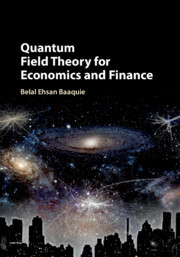Description
Quantum Field Theory for Economics and Finance
Author: Baaquie Belal Ehsan
An introduction to how the mathematical tools from quantum field theory can be applied to economics and finance.
Language: English
Subject for Quantum Field Theory for Economics and Finance:
Approximative price 196.62 €
In Print (Delivery period: 14 days).
Add to cart
Publication date: 08-2018
714 p. · 17.8x25.3 cm · Hardback
714 p. · 17.8x25.3 cm · Hardback
Description
/li>Contents
/li>Biography
/li>
An introduction to how the mathematical tools from quantum field theory can be applied to economics and finance, providing a wide range of quantum mathematical techniques for designing financial instruments. The ideas of Lagrangians, Hamiltonians, state spaces, operators and Feynman path integrals are demonstrated to be the mathematical underpinning of quantum field theory, and which are employed to formulate a comprehensive mathematical theory of asset pricing as well as of interest rates, which are validated by empirical evidence. Numerical algorithms and simulations are applied to the study of asset pricing models as well as of nonlinear interest rates. A range of economic and financial topics are shown to have quantum mechanical formulations, including options, coupon bonds, nonlinear interest rates, risky bonds and the microeconomic action functional. This is an invaluable resource for experts in quantitative finance and in mathematics who have no specialist knowledge of quantum field theory.
Foreword; Preface; Acknowledgements; 1. Synopsis; Part I. Introduction: 2. Quantum mechanics; 3. Classical field theory; 4. Acceleration action; 5. Option theory; 6. Path integral of asset prices; Part II. Linear Quantum Fields: 7. Scalar quantum field; 8. Dirac spinor field; 9. Photon gauge field; 10. Forward interest rates' quantum field; 11. Risky interest rates' quantum fields; 12. Bonds: index-linked stochastic coupons; Part III. Nonlinear Quantum Fields: 13. Operator expectation and S matrix; 14. Nonlinear scalar field: Feynman diagrams; 15. Renormalization; 16. β-function; fixed points; 17. Renormalization group and phase transitions; 18. Effective action; 19. Nonlinear interest rates' quantum field; 20. Simulation of nonlinear interest rates; 21. Interest rates range accrual swap; Part IV. 2D Quantum Fields: 22. Two dimensional quantum electrodynamics; 23. Bosonic string theory; 24. Futures asset prices; 25. Epilogue; References; Index.
Belal Ehsan Baaquie is a Professor at The International Centre for Education in Islamic Finance. He received his training in theoretical physics at the California Institute of Technology and Cornell University, New York, specializing in quantum field theory. He later developed an interest in finance and economics, and started applying quantum mathematics to these fields. He has written two books on quantum finance: Quantum Finance (Cambridge, 2007) and Interest Rates and Coupon Bonds in Quantum Finance (Cambridge, 2009) in addition to several other books focusing on topics from quantum mechanics and mathematics to books on the leading ideas in science.
© 2024 LAVOISIER S.A.S.




